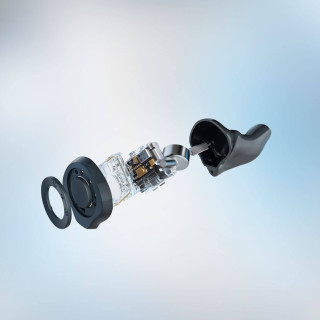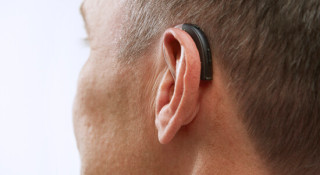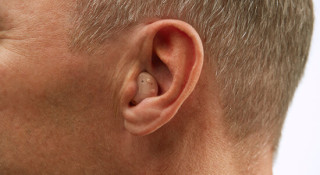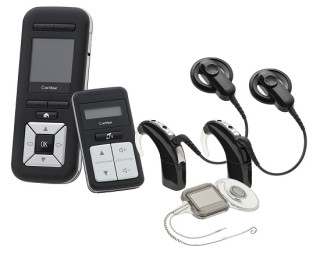
Hearing Aids
The A to Z of hearing aids at Audiology South
At Audiology South, we’re committed to helping you hear your best with the latest hearing aid technology. We offer a variety of brands so you can find the one that fits best to you.
How does a hearing aid work?
A hearing aid picks up sounds, makes them clearer and louder, and sends them into your ear. The sound travels through the middle ear to the inner ear, where the hearing nerve sends signals to your brain, helping you hear the world more clearly.
While hearing aids may differ in style, they all work similarly. The right choice for you depends on your ear canal shape, hearing loss severity, and lifestyle. Some people have more earwax or sweat, while others may not like having something in the ear canal. Our expert audiologists are here to guide you and help you find the best fit!
Types of hearing aids

Receiver In The Ear
RITE, RITC or RIC
The great thing about this style is how small and discreet it is, making it a popular choice for those looking for something less noticeable. With the electronics placed behind the ear and the speaker gently fitting into the ear canal, these hearing aids provide a rich, full sound experience. In fact, it might even feel like you’re not wearing a hearing aid at all!
RICs are available in rechargeable or battery options, in entry-level aids through to the most advanced technology.

Behind The Ear
BTE
These hearing aids sit comfortably behind the ear and connect to the ear canal with a tiny tube or custom ear mould. Over the years, they’ve evolved to be much more discreet and come in a variety of fun colours, so you can choose something that blends in or stands out—whatever suits your style!
Because they’re positioned away from the ear canal, they’re super reliable and less affected by earwax or moisture. If you need something with great power or find handling easier with a larger device, this style could be a perfect fit for you!

Custom Hearing Aids
These hearing aids are custom-made just for you, designed to perfectly fit your ear. Some are so small they sit deep inside the ear canal—these are called IIC (Invisible in the Canal) or CIC (Completely in the Canal). They’re super discreet, making them a great choice for anyone who wants their hearing aids to stay hidden. Plus, they’re perfect for people who use the phone a lot or work outdoors where wind noise can be a problem for other types of hearing aids.
For those who need a bit more power or find small devices and batteries tricky to handle, there are also slightly larger options like ITC (In the Canal) or ITE (In the Ear) hearing aids. These can be easier to manage and might be a great fit for someone who’s new to hearing aids or a bit older and looking for a simple, easy-to-use option.
Specialised hearing aids
There are hearing aids designed for specific types of hearing loss, like CROS and BiCROS systems for significant hearing loss in one ear. These systems help by sending sound from the weaker ear to the better ear, making it easier to hear, especially in noisy environments.
To go rechargeable or not
Rechargeable hearing aids are perfect for those with limited dexterity, vision impairment, or busy lifestyles. Simply charge them overnight and wear them all day—no need to worry about changing batteries. Plus, the built-in battery lasts the life of the device, making them more eco-friendly than disposable battery models.
Most hearing aid brands now offer rechargeable options, with new ones hitting the market every month. Be sure to ask us about the latest options!

Cochlear Implants
A cochlear implant is a medical option for severe hearing loss in both ears. This surgically-implanted device bypasses the damaged part of the inner ear and directly stimulates the hearing nerve to convert sound into electrical signals, just like a healthy ear.
At Audiology South, we can help determine if a cochlear implant is right for you. We’ll guide you through the evaluation process, assist with referrals, offer medical and funding advice, and even connect you with others who use cochlear implants.